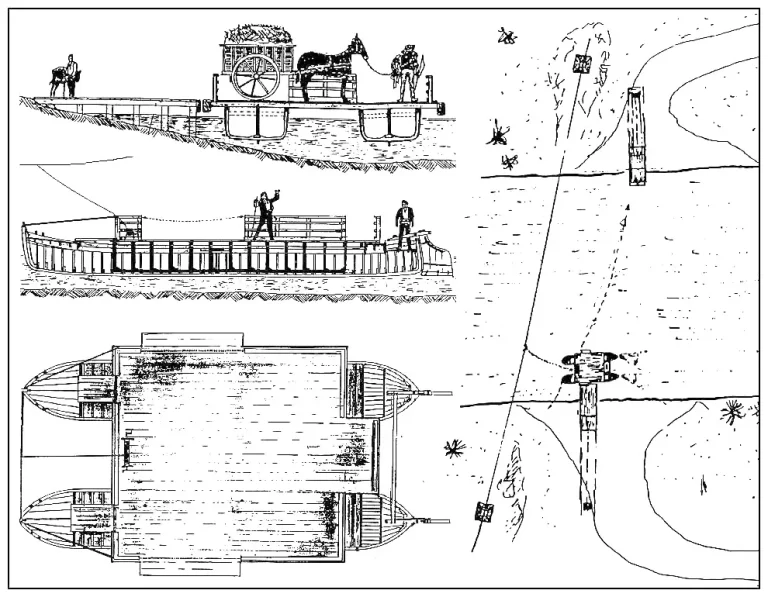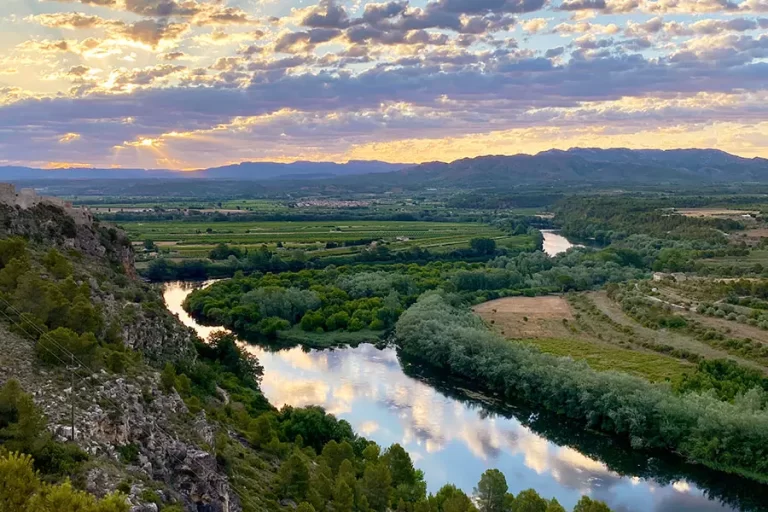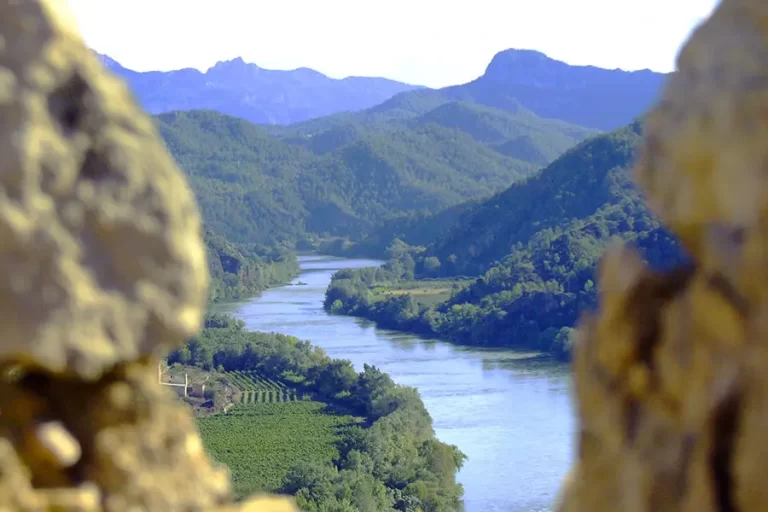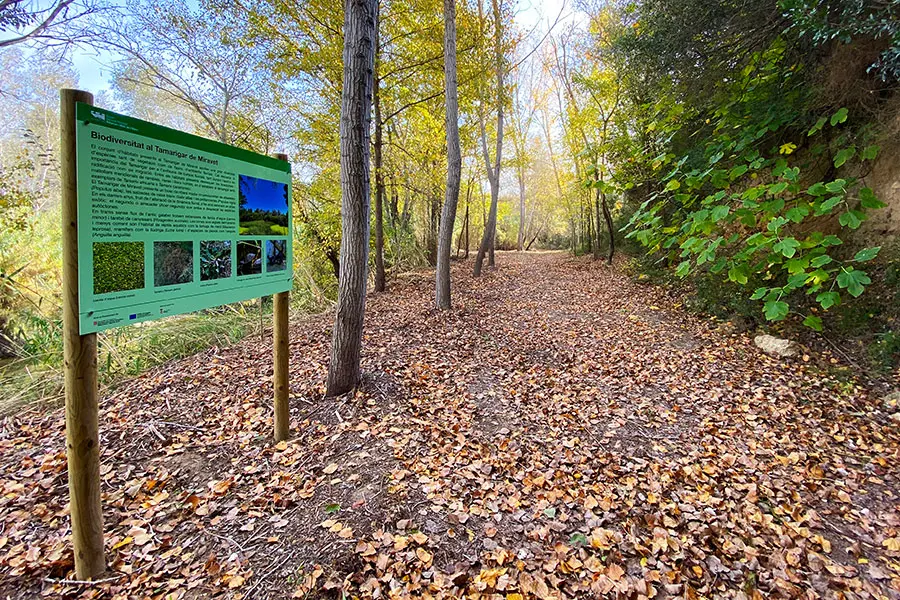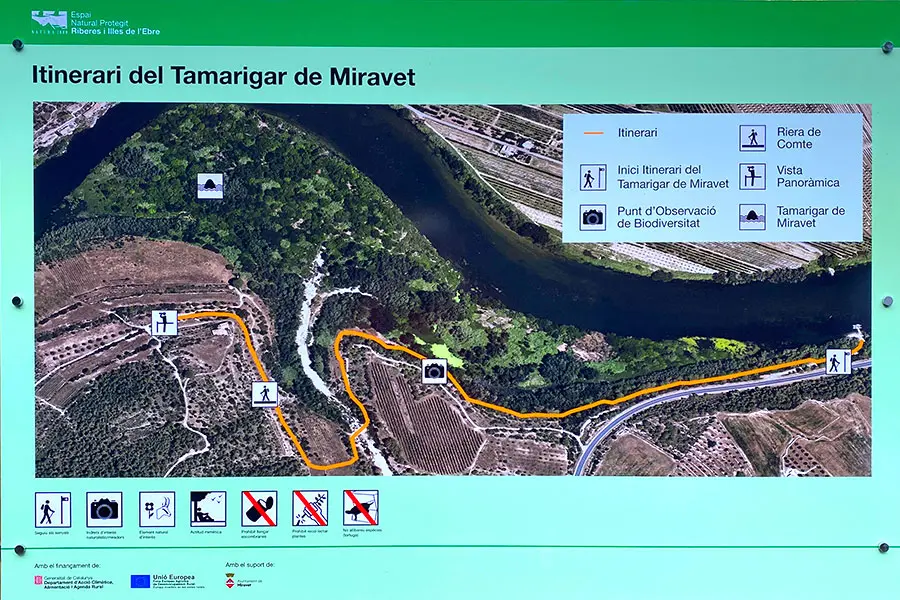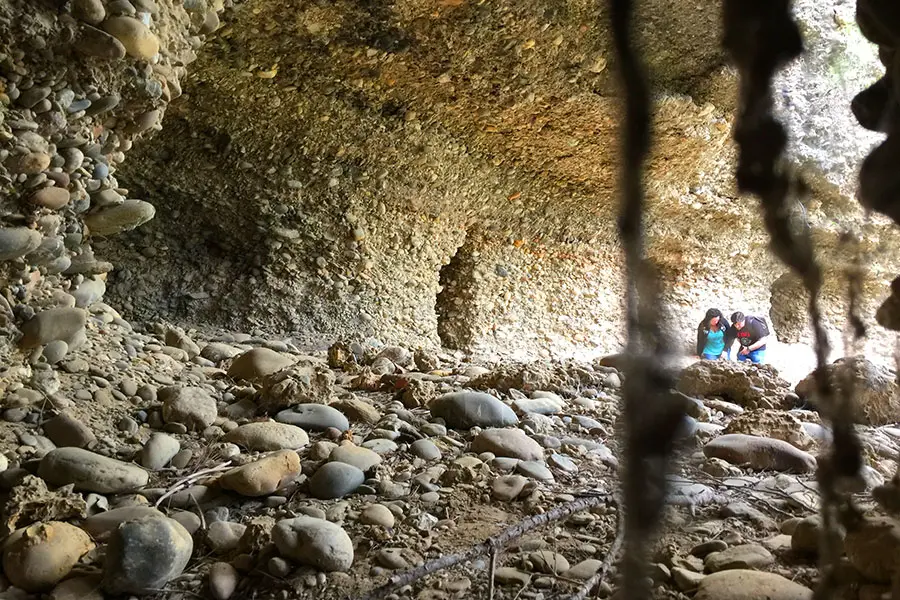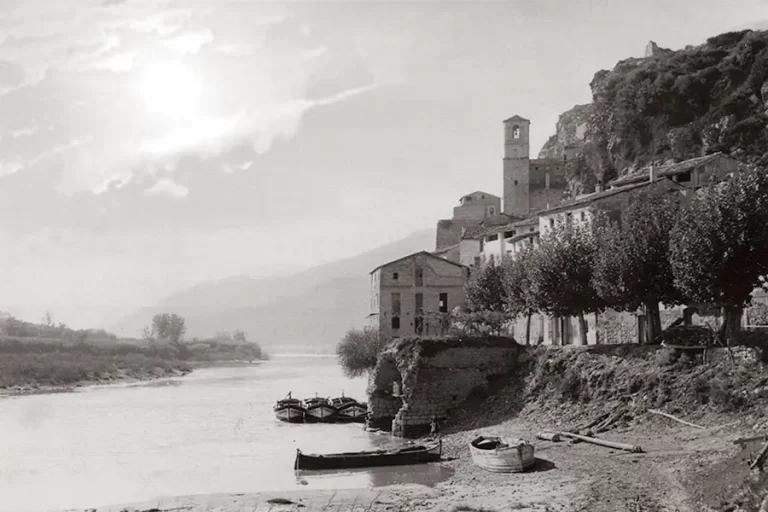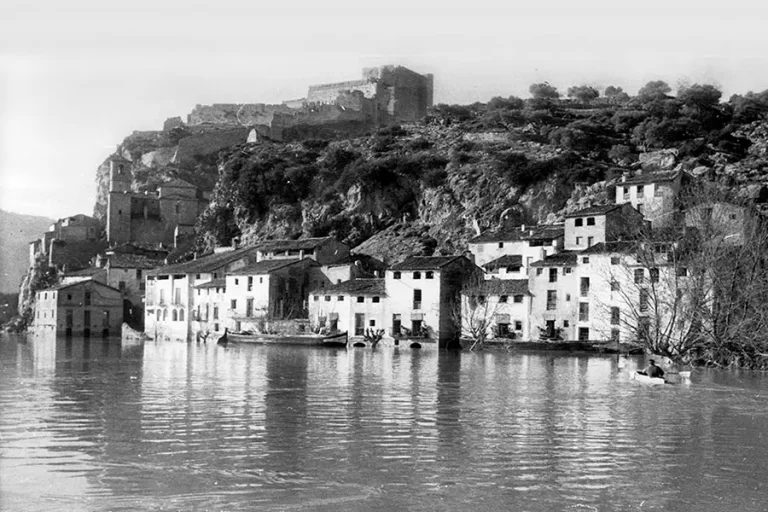The Ebro River and the crossing boat
The Ebro River in Miravet is an ideal oasis for canoeing, walking routes, and the crossing boat of Miravet is the last original and traditional without motor.
Miravet, a natural paradise
From Palau de Miravet and El Balcó de Miravet you will enjoy the majesty of the landscape in front of the river with privileged views.
The last original and traditional ferry on the Ebro.
La Ribera d’Ebre, a paradise for kayaking lovers.
The Ebro River in Miravet
The Ebro river is life; landscape, nature and culture.
Meanders, islands and delta. Mountains and narrow passes. Farmland, villages and boats.
Natural parks, biosphere reserves and biodiversity.
When you reach the Ribera d’Ebre, having traveled almost a thousand kilometers, you will find yourself in the embrace of the mountains that force you to bend, dodge and cross islands, meanders, cliffs and narrow passages, as is the case of the Barrufemes Pass in Miravet.
On its way, the river is welcomed by ancient villages of Iberians and laguters, leaving lush riparian forests and fertilizing fields of olive trees, vines, peach and cherry trees, before continuing to the sea.
The heart of the biosphere reserve is the Ribera d’Ebre.
The Ebro River in Miravet
An incomparable setting of incredible beauty!
The crossing boat (Pas de Barca)
Crossing the river by boat is a unique experience.
The Miravet crossing boat is the last vestige of traditional, non-motorized river navigation along the Ebro. A ferry with a platform on two original llaguts, which allows us to cross the river by vehicle or on foot, using the current of the water.
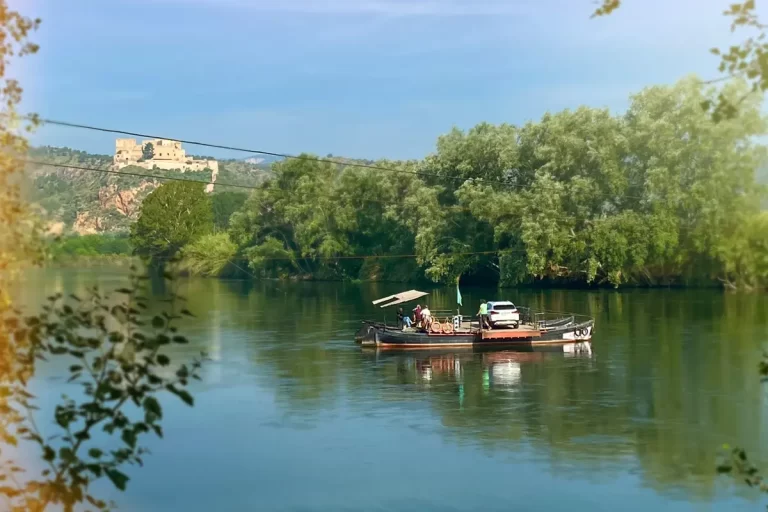
Boat passing timetables
Every day from 8 am to 1 pm and 3 pm to 7 pm (6 pm in winter or sunset).
* Sundays and holidays open at 9:00 am.
Weekends from Easter to All Saints’ Day do not close at noon.
August: every day from 8 am to 8 pm.
Easter week from Friday to Monday does not close at noon.
CLOSED (red flag): 25 and 26 December / 1 and 6 January / due to inclement weather such as rain or strong winds and floods.
* It is not allowed to cross with a caravan.
Pass-through service rates
- Cars: 3,00€.
- Residents of Miravet: 2,00€.
- Regular users (commercial, farmers, etc.): 1,75€.
- Motorcycles over 50cc: 2,50€.
- Motorcycles up to 50cc: 2,00€.
- Bicycles: 1,50€.
- People on foot: 1,00 € 1,00
Passage boats
sustainable engineering
Humans, on their way from one place to another, have had to overcome the geographical accidents that nature has imposed on them. One of these difficulties was the crossing of rivers. In the Ebro, a wide and fast-flowing river, an original means of transport was used: boats.
The origins of the passenger boats can be traced back to time immemorial. That of Miravet appears referenced in a conflict between the Templars and the Entença for the collection of the right of way.
They were usually installed in places of surveillance or easy defense. All of them were owned by the jurisdictional courts, which leased them. Nowadays, Miravet’s is managed by the town hall.
It is formed by two llaguts on which rests a wooden platform. So that the current of the river does not carry it away, it is attached to a metal cable called ramalet, which is linked to the gumena, another thicker cable that crosses the river at a certain height from the water, the ends of which are strongly embedded in a pylon on both sides of the river. The entrance and exit of the platform is done through a mobile jetty that raises or lowers depending on the river flow. The boat is propelled by the current of the river and the skillful hand of the boatman, who dominates the rudder and makes it maneuver with mastery.
In the past it played a very important role, since due to the lack of stable bridges, it was necessary to resort to these mobile means to trade between the towns on both banks, to cross transhumance herds in search of new pastures, the farmers to work the land they had on the other side of the river, allowing the passage of public services such as the post office and order, and even to attend the festivals and fairs of the neighboring towns.
Today the boats of Miravet, Garcia or Flix are the only living testimony of the ancient river navigation on the Ebro.
An ecological, sustainable and modern system prepared for the future…
Activities on the Ebro River
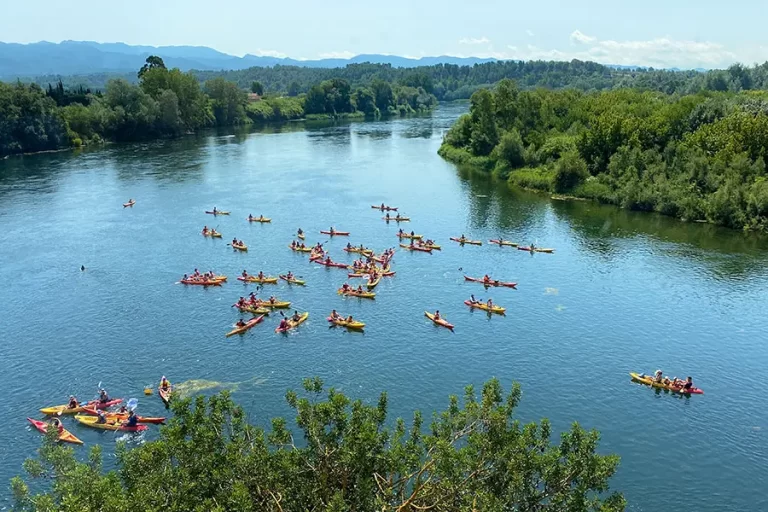
Canoeing in the Ebro
The most fun and recommended activity to discover the river and enjoy with friends and family is, without a doubt, canoeing or kayaking in the calm waters of the Ebro River.
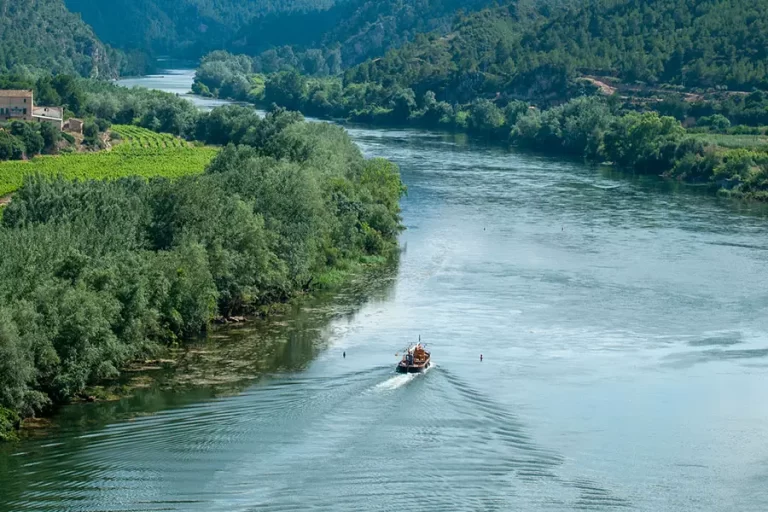
Cruises on the Ebro
You can enjoy sailing on the Ebro with boats such as the Llagut of Benifallet or ‘Lo Roget’ of Ascó and ‘Lo Sirgador’ of Tortosa.
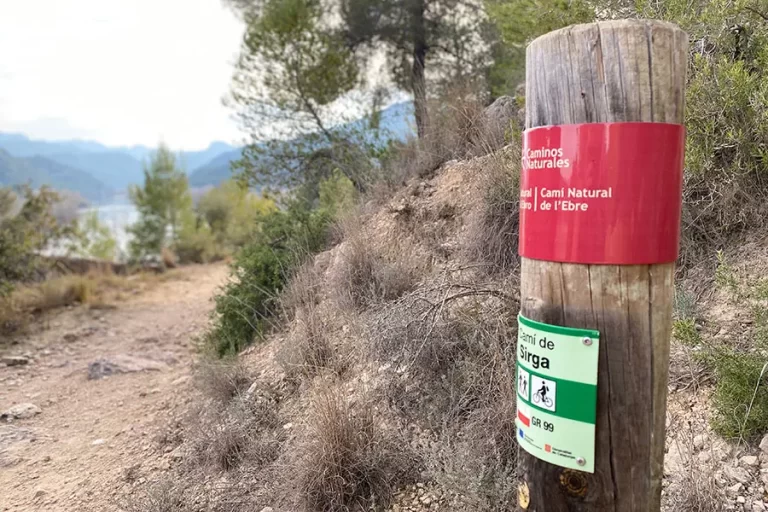
Ebro Trail GR99
The GR-99 or Ebro Trail runs along the river from beginning to end. Between Miravet and Benifallet it crosses the Barrufemes Pass, 4.5 km away. A stretch of special interest.
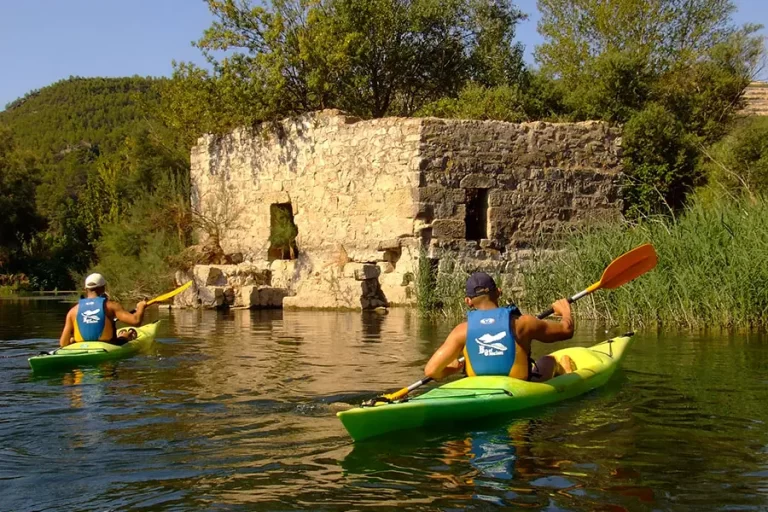
The Miravet lost weir
In the Ebro river there are three significant dams, the Xerta dam, the Ascó dam and a third one submerged in Miravet next to a medieval construction with evidence of a sluice system. It is called ‘Molinot’, accessible by boat or kayak from the river itself.
The meander of the Tamarigar
In front of the Cap de la Vila de Miravet there is a large meander of 7 ha. It is a natural and ornithological reserve with a great variety of trees and bushes, where the tamarind (Tamarix) stands out, as well as aquatic birds and birds of prey, perfect for birdwatching.
The Barrufemes Pass
The Ebro, as it passes through Miravet, meanders and crosses the Sierra de Cardó through the Barrufemes Pass, which marks the boundary between the Ribera d’Ebre and the Baix Ebre. It is a completely wild, rocky and leafy stretch with vertical and oblique limestone folds, such as the Follatera Rock.
What to see at the boat pass
Interesting places to enjoy nature and history
Aubasta path
A very pleasant walk with views along the river bank, the riparian forest and crop fields, reaching Ginestar (3 km).
Tamarigar path
Itinerary through the riverside forest to the Mas de Reparo, with views of the castle. It borders the Tamarigar Natural Reserve (1 km).
River navigation
Man has always navigated the Ebro with adapted boats: llaüts, pontoons, crutches and boat crossings, such as the one at Miravet, of different sizes and shapes.
To talk about river navigation on the Ebro is to talk about the past, when the llaüts sailed the river from Logroño and Tudela to Tortosa.
The traditional navigation of the past is part of the memory and has been immortalized in images and films, such as Joaquim Mir’s 1929 film, or the well-known book by Jesús Moncada, “Camí de Sirga”.
The recovery of the navigability of the Ebro is being carried out in 6 sections, between the mouth and Ribarroja de Ebro (128 km):
– Mouth-Amposta (26 km): perfectly navigable with boats with a maximum draught of 1.5 meters.
– Amposta-Tortosa (17 km): navigable for boats up to 50m in length and 1.5m draught, following the indications of the navigable channel (50 m wide). Minimum flow of 80m2/s.
– Tortosa-azut de Xerta (18 km): navigable with boats of 80cm to 1m draught, following the indications of the navigable channel and taking care with the river beaches and sedimentary deposits of ravines and torrents. Minimum flow rate: 100m2/s.
– Assut-Benifallet (12km): perfectly navigable due to the stagnation of water in the weir with boats with a maximum draught of 1.5m.
– Benifallet-Móra d’Ebre (11 km): navigable with lighter boats with a maximum draught of 40 cm and a retractable motor, taking extreme precautions due to the presence of submerged mobile bodies of sand that reduce the depth. Minimum flow rate: 100-150 m2/s. This section, on the other hand, is ideal for canoeing, given the presence of numerous beaches, islands, meanders and natural alternative channels that invite discovery, stops and bathing, in addition to crossing one of the most impressive natural and wild environments of the entire Ebro (Miravet and Barrufemes pass).
– The stretch between Móra d’Ebre and Riba-roja d’Ebre passes through the Ascó weir, the meander and marsh of Flix, but you can practice canoeing and rent boats-apartments in the reservoir of Riba-roja d’Ebre.
– Pairs of side buoys, following the AISM (International Association of Maritime Signaling) system, with red-port (cylindrical) and green-starboard (conical) buoys.
– Code of vertical signs announcing the bridges, the weir and the Miravet boat crossing.
– All the villages in the project have ramps and jetties.
Information (IDECE): 977 510 556 (regulations, companies that comply with current LEGALITY, situation of the navigable channel, season, various services, etc).
Floods in the Ebro
The Ebro is the fastest flowing river in the peninsula (between 100 and 500 m3/s). Every few years, it suffered overflows and floods, some of them catastrophic and transforming its course.
The floods provided fertility to the land and nourished the delta with the sediments necessary to maintain its ecosystem, often at the cost of lives and great destruction.
The catastrophic flood of 1787, about 22,000 m3/s, covered the entire village up to the roof of the Palau and the chapel of Sant Domingo.
Extract from the resolution of King Charles III approving the exemption of the Cadastre:
“That the city of Tortosa, and the towns of Amposta, Aldover, Cherta, Tivenys, Benifallet, Ginestar, Miravet, Benisanet, Mora de Ebro, Ascó, Flix, Rivaroya, are exempt from the land tax for four years, with a declaration that although this grace is absolute in common, it does not comprise to the Neighbors, and landowners that can pay, so that with those that of these it is demanded, to help, and to foment to those that for having been but unfortunate they need of greater aid, that the one of the pardon of the contribution to return to their respective works.“.
Other historic floods were those of 1488, 1582, 1617, 1743, 1907, 1937 (in the middle of the Spanish Civil War) of between 6,500 and 9,400 m3/s.
And among the most recent are those of 1956, 1961, 1982, 1997, 2001, 200 and 2015, when the water covered the Arenal Square reaching, in some cases, the second floor of the nearest houses on the river.
You will find plaques with the marks and date of some of these floods Bar Amadeo, the Palau de Miravet and the Portal del Motxo.
